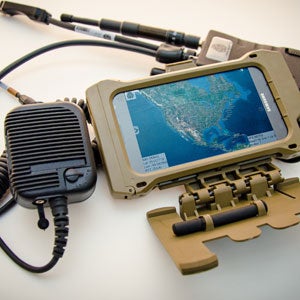Imagine mobile communication gear that creates its own ad hoc network

The Defense Advanced Research Projects Agency is the modern day iteration of what began as APRA (same meaning without “defense”), which created the ARPANET, to which we all owe the modern day internet, which is what makes all of this fancy mobile technology stay connected.
FLASH utilizes Wave Relay radio technology developed by a company called Persistent Systems, which is headquartered in India, and is on the leading edge of technology that touches banking, healthcare, life sciences, media, and telecommunications. Wave Relay forms a mobile network that is able to bounce signals between nodes, and around obstacles (the terrain at Yarnill Hill is quite rugged).
The handhelds are Android powered devices (one example from DARPA’s site is a Samsung device – looks like a Galaxy S4) running a software suite from Digital Precision, and the system has seen use throughout the west, particularly California, where wildfires are common. Last month, the California National Guard deployed a drone which assisted firefighters using FLASH while they fought a wildfire at Yosemite National Park. NASA has adopted the system as well.
The fire department in Prescott, Arizona began testing FLASH this past spring, and it has impressed Fire Battalion Chief Ralph Lucas III, “Everybody can see you, and you see everybody, and you can communicate with everybody.”
FLASH can also connect with civilian infrastructure, like mobile networks and the internet. During the last run of testing, a team at DARPA in Virginia was able to seamlessly track everything happening in Arizona. Development is ongoing, but Chief Lucas wants to begin beta testing next spring. DARPA and Persistent Systems will be demonstrating the technology next to the United States Forestry Service. Below are some pictures, and a video demonstration of the FLASH prototype.

source: Popular Mechanics and DARPA
Follow us on Google News














Things that are NOT allowed:
To help keep our community safe and free from spam, we apply temporary limits to newly created accounts: